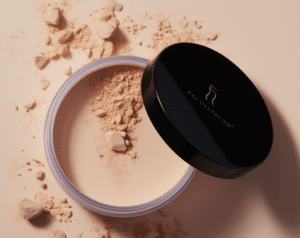Introduction – DIY Face Powder
[Disclaimer: we are not cosmetic experts. The information we’ve gathered for DIY face powder is for educational purposes only. Please be careful when making and using your own cosmetics.]
The do-it-yourself trend has traversed various fields, arriving at skincare and homemade beauty products. As an increasing number of people are prioritizing personalized skincare, making DIY face powder a great opportunity for customization.

Why Should You Make Your Own Face Powder?
Making your own face powder and makeup products is a combination of three powerful features: it’s cost-effective, free from harmful chemicals, and tailored to suit your skin type.
Making your own cosmetics gives you full control over the ingredients, empowering your skincare routine.
Sustainability and Carbon Reduction
Creating your own beauty products is more sustainable and reduces your carbon footprint. By making your own face powder, you’re reducing the packaging typically associated with commercially produced cosmetics.
Opting for natural and organic ingredients also supports sustainable farming practices, doubling the positive impacts of your DIY endeavors.
Powdered Foundation Recipe
Materials Needed
- Mortar and Pestle: This is an essential tool to finely grind and mix your ingredients.
- Where to buy: Most kitchen stores, home goods stores, or online marketplaces like Amazon offer a range of mortar and pestles. Look for one made from non-porous materials like ceramic, granite, or marble.
- Cornstarch: Acts as the primary base for the powder.
- Where to buy: Almost any grocery store will have cornstarch in the baking aisle. Make sure it’s pure and doesn’t contain any additives.
- Base Powder:
- Cocoa Powder or Finely Ground Cinnamon: Acts as the color base. Adjust the quantity to match your skin tone. Cocoa powder will give a brown shade, while cinnamon can add a warm, tan hue.
- Where to buy: Grocery stores, in the baking or spice section. If possible, choose organic or untreated varieties.
- Cocoa Powder or Finely Ground Cinnamon: Acts as the color base. Adjust the quantity to match your skin tone. Cocoa powder will give a brown shade, while cinnamon can add a warm, tan hue.
- Cosmetic-Grade Mica: This adds shimmer to the powder. Ensure you get “cosmetic-grade” to be safe for skin application.
- Where to buy: Cosmetic stores, some craft stores, or online retailers that specialize in DIY cosmetic ingredients.
Instructions
- Preparation: Make sure your workspace is clean. This will help prevent any contaminants from getting into your homemade foundation.
- Mixing: In the mortar, start by adding your desired amount of cornstarch as the base. Slowly incorporate the cocoa powder or cinnamon, a little at a time, until you achieve the shade close to your skin tone. Remember, it’s easier to darken the mixture than to lighten it, so start with smaller amounts.
- Shimmer: If you want a shimmer effect, slowly mix in a tiny amount of cosmetic-grade mica until you achieve the desired shimmer effect. A little goes a long way, so be careful not to overdo it.
- Grinding: With the pestle, grind and mix the ingredients thoroughly in the mortar until you achieve a smooth, fine texture. This ensures even application on your skin.
- Testing: Test the foundation on the back of your hand or jawline to see if it matches your skin tone. Adjust the quantities as needed.
- Storage: Store your homemade powdered foundation in a clean, airtight container. Old makeup containers that have been cleaned and sterilized are perfect for this.
Customizing Your Powdered Foundation
From the base, you can further customize your homemade face powder. Add arrowroot powder for a silky texture or kaolin clay if your skin type is oily. Adding beetroot powder will give you a blush tone. Store the product in a clean, air-tight container.
Brand Review: Nature’s Garden Organic Cocoa Powder
Organic Cocoa Powder, as provided by Nature’s Garden, stands out as a multifaceted ingredient beneficial for various cosmetic and skin care applications.
Derived from nutrient-rich cacao beans, this cocoa powder boasts a variety of vitamins such as A, B1, B2, B3, C, E, and pantothenic acid, along with minerals like magnesium, calcium, and zinc.
The presence of caffeine, naturally found in cacao beans, can have advantageous effects on the skin, such as revitalizing and improving circulation.
This makes the organic cocoa powder a promising ingredient for DIY face powder formulations, offering potential nourishment and a natural brown hue.
Moreover, its versatility extends to its incorporation in bath teas, shampoos, conditioners, lotions, face masks, and lip balms, demonstrating its adaptability across various cosmetic recipes.
Take note of the manufacturer’s cautionary guidelines: Nature’s Garden’s products, including this cocoa powder, are strictly for external use and should never be consumed.
Users should refrain from perceiving or marketing them as medical or curative solutions. For any health-related queries or concerns regarding the product, consulting a healthcare professional is always advisable.
Brand Review: Starwest Botanicals Organic Arrowroot Powder
Arrowroot (Tapioca) Powder Organic, derived from the root of the tropical plant Manihot esculenta, offers a more natural alternative to conventional starch powders due to its extraction method, which avoids the use of high heat or chemicals.
Originating from Thailand and Vietnam, this powder is both gluten-free and non-GMO, making it suitable for those with specific dietary requirements.
Given its natural thickening properties and its ability to act without altering the food’s color or taste, it presents itself as an ideal substitute for cornstarch in DIY face powder formulations.
Furthermore, its minimal processing ensures a closer-to-nature product, which is often sought after in homemade cosmetic preparations.
The product’s texture and neutral characteristics might contribute to a smooth finish and even consistency in face powders, potentially making it a favorable ingredient for those venturing into DIY cosmetics.
Precautions and Tips

- Conduct a patch test before using the foundation on your entire face to ensure there’s no allergic reaction.
- Over time, you might find the foundation settling in the container. Just give it a shake or stir before using it.
- As this is a homemade product without preservatives, make small batches to ensure you’re using fresh product and avoid contamination.
- Store it in a cool, dry place, and remember that due to the natural ingredients, the shelf life would be shorter than commercial makeup products.
Conclusion – DIY Face Powder
Making your DIY face powder is a fun, eco-friendly project that brings out the best for your skin. Experiment and find out which ingredients and ratios work best for your skin because, after all, the beauty of DIY is customization!
Further Resources
Create other beauty products using these chemical-free methods and organic ingredients. For more in-depth guides and expert advice, check out online resources, beauty blogs, and DIY skincare communities where you can share and learn from fellow skincare enthusiasts.
